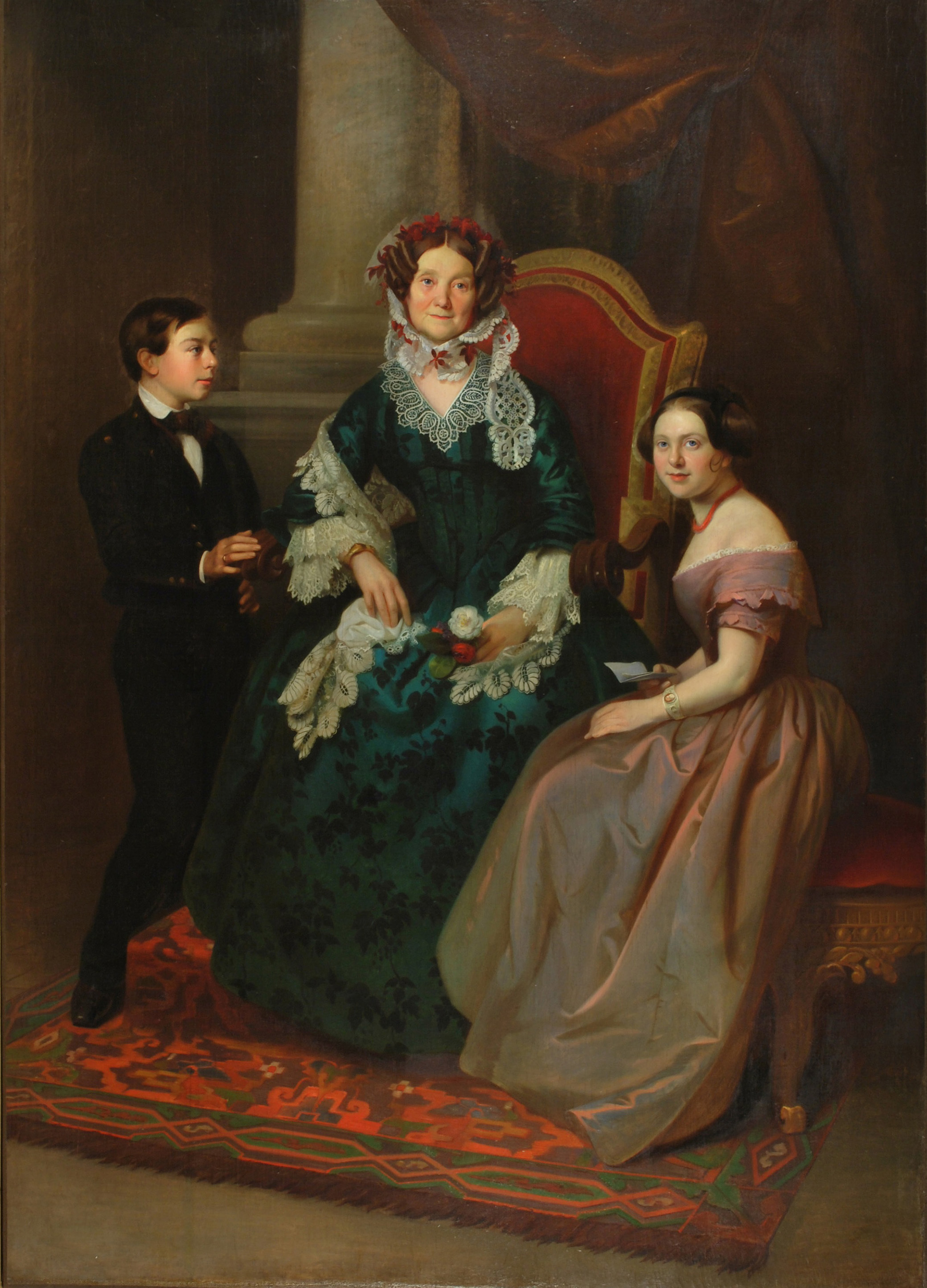
Eliza Jumel and Her Grandchildren, by Alcide de Ercole, 1854. Morris-Jumel Mansion Photo Archives.
Audio brought to you by Curio, a Lapham’s Quarterly partner
Set on a green lawn at the edge of northern Manhattan, the Morris-Jumel mansion, white and stately, might seem charming enough on a sunny afternoon. This evening, however, is a blustery, gray one. As the doorbell echoes inside I wait on the porch where, more than fifty years ago, a woman appeared on a balcony above and told a group of field-tripping schoolchildren to shush. When the tardy curator finally arrived to open up the house, she insisted that the house had been empty. She had been elsewhere, the door was padlocked, and no one could have entered. But the woman described by the children sounded familiar—just like Eliza Jumel, the mansion’s former owner. She had died in 1865.
Eliza was a revolutionary woman for her time—a sharp businessperson who started life in the lowest tier of American society and courted controversy as she climbed to the top. Her posthumous reputation suffered even more. It was said that she had killed her husband for his money and that, after her own death, her ghost wouldn’t leave the house.
She herself had claimed the place was already haunted when her husband bought it in 1810. Built by Colonel Roger Morris, a British loyalist, and commandeered as George Washington’s headquarters during the Revolutionary War, the building had quartered Hessian mercenaries before briefly becoming a tavern in 1789. Now, a century and a half after she died, Eliza’s ghost is supposed to linger here still.
The management resisted ghost hunters for a long time after the mansion became a museum in 1904. On occasion, though, visitors would report an encounter with Eliza, or a Hessian soldier rumored to have died on the stairs, or a maid who had jumped out a window. The house had a long enough history to have accumulated a cast of ghosts, some quite famous: General Washington himself was said to pace the floors, and some felt the presence of the man Eliza married after her first husband died, former vice president Aaron Burr.
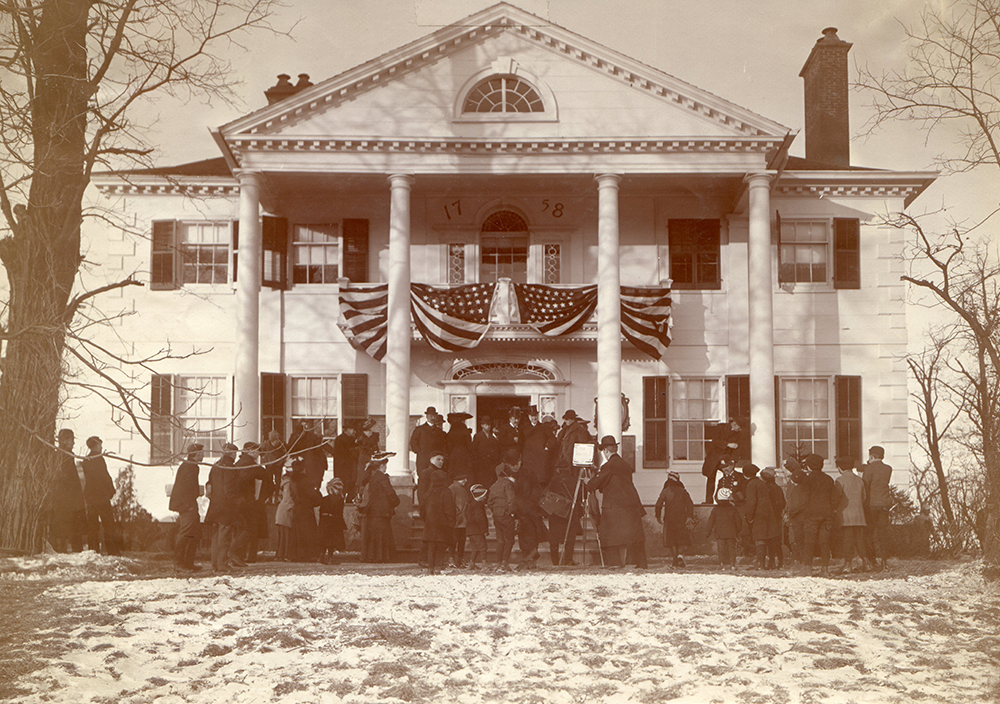
For decades, most of the mansion’s past, including its ghosts, was left to languish while the curators focused on the few weeks Washington had spent there. There was some worry, too, that the ghost stories might goad leery, superstitious neighbors to attack the house. But now there are regular paranormal investigations inside the historic location, in which small groups of people try to communicate with the mansion’s phantom residents. Vincent Carbone, who is both ghost hunter and events manager at Morris-Jumel, had promised to show me techniques for connecting with the dead, as well as explain why a historical museum might lean into being a haunted house.
Born in 1775, Eliza had a troubled backstory fitting for a future as an alleged ghost. She grew up poor in Providence, Rhode Island, just like her mother, who worked as a hired servant. In New York a rumor spread that her mother had worked in a brothel when Eliza was young. Their family struggled enough that Eliza lived in a workhouse for a time before she was able to make her way to New York City. She worked as an actress and married into money, making a social leap so large that gossips said she had manipulated Stephen Jumel, a French-born merchant, into proposing.
Stephen had moved to New York City in the 1790s. He and Eliza may have met at a theater where she worked as an extra, a badly paid position that allowed women to catch the eye of men who might support them. According to New York’s rumor mill, Eliza had been Stephen’s mistress, and they married only because she had pretended to be on her deathbed, claiming it was her dying wish to be wed.
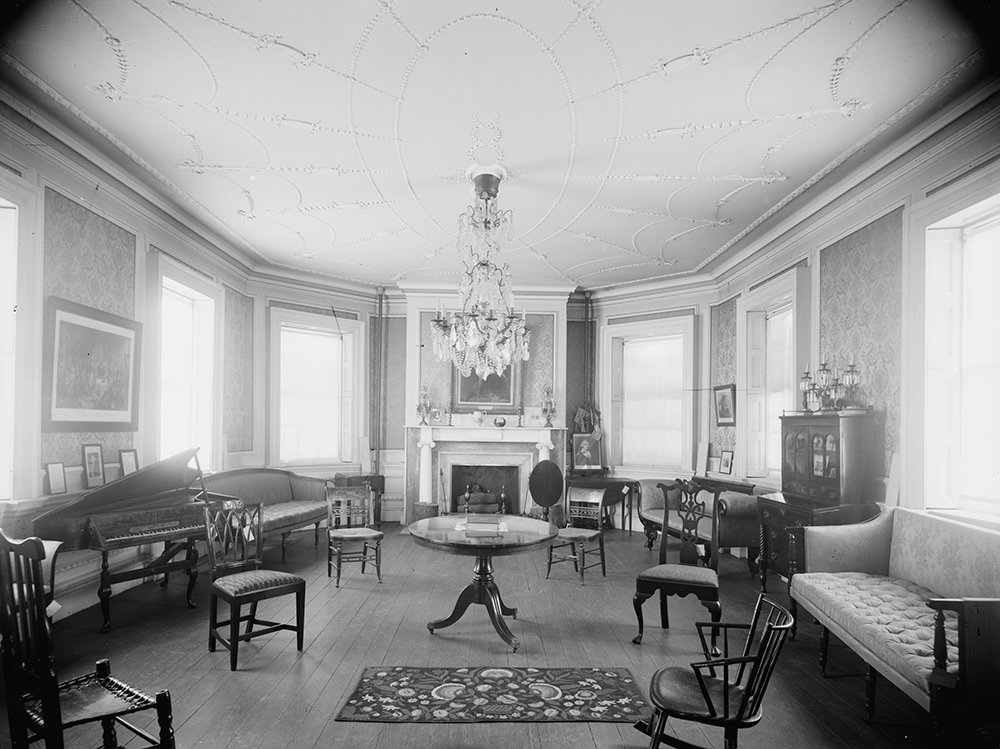
Her shrewd business sense and able management of her husband’s properties made contemporaries uncomfortable, too. For many of the years of their marriage, Stephen lived in France while Eliza lingered in America, ostensibly to see to money matters. Her husband eventually returned to New York, but he died more than thirty years before her. The story goes that the night after he fell off a hay cart and onto a pitchfork, she removed his bandages and allowed him to bleed out.
Not long after Stephen’s death, Eliza married Aaron Burr. In theory, they each had assets to bring to the marriage—his respectability and power, her money. But it was a short-lived relationship, set on the shoals when Eliza realized Burr was using her money to pay off his debts. She sued for divorce. (It technically never went through, because Burr died before the case concluded.)
Eliza spent the rest of her life ruling over the mansion on the hill and her extended family, including the grandchildren of her much-loved sister. But when she died at age ninety, she left much of her large estate to a local church and other charities, to the surprise of her relatives, who had expected a more generous inheritance. They spent two decades fighting Eliza’s will and when they succeeded sold the land and house to a syndicate of land developers. For years after that the house stood empty. Ultimately the city took possession of the property and transformed the house into a museum.
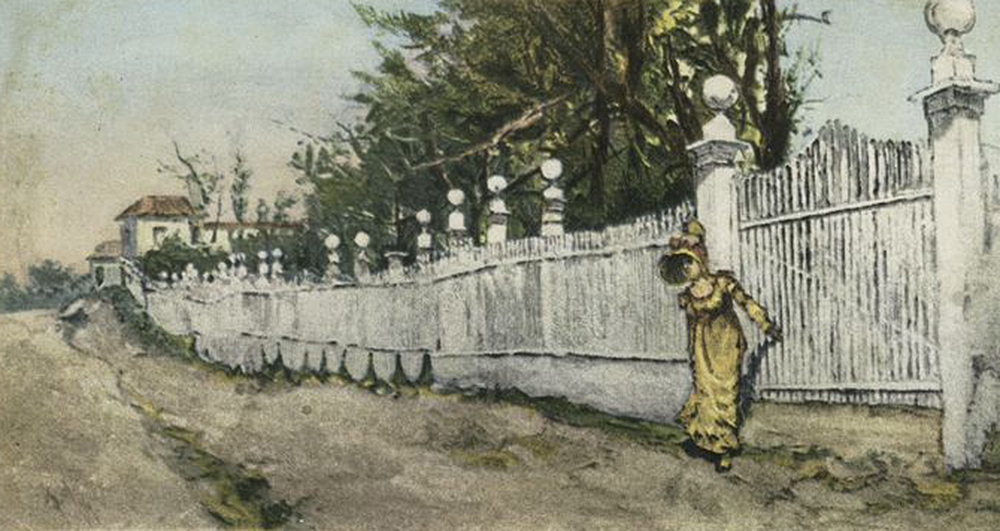
Most of the museum’s visitors don’t come here looking for ghosts, and not everyone on staff buys into the stories. A former staffer who, a few years ago, would stay from the time to time in the caretaker’s basement apartment sometimes heard heavy footsteps above her head, even when the house was supposed to be empty. She told Carbone she doesn’t believe in visitors from beyond. But some staffers keep a log of strange experiences: disembodied voices, doors opening, lights being turned on and off. On one recent occasion, when the house and grounds were closed, two people in the first-floor gift shop heard women downstairs laughing and a table scraping against the floor. They ran to check every room and found no one. The six-foot-long wooden table in the kitchen, they noticed, had been pushed off-kilter.
Carbone, a brisk and businesslike Long Island native, works at a paper-strewn desk under the eaves of the house’s creaky top floor. He started his career as a paranormal investigator after an uncanny experience working the night desk in his college dorm in Brockport, New York. One midnight hour, the sink in an empty bathroom turned on, and the elevator kept opening its doors, empty. He found out later that, back in the 1990s, a student had hung himself where the night desk sat.
A few years ago, Carbone happened to call Morris-Jumel to inquire about a ghost hunt for the bachelor party of a friend and fellow investigator right when the mansion was in need of a ghost hunter. Not all historic houses have ghosts to boast of, but some that do make the most of their natural resources. In New York, the Merchant’s House Museum offers candlelight ghost tours, and it’s possible to rent out certain National Trust Historic Sites for paranormal investigations. Some houses offer ghost-hunting classes. Ghosts can bring in guests who otherwise might not be inclined to join a historic house tour and create a new source of income for sites that struggle to stay open. Since Carbone started working at Morris-Jumel full-time at the start of 2016, the mansion has hosted sold-out public paranormal investigations about once a month.
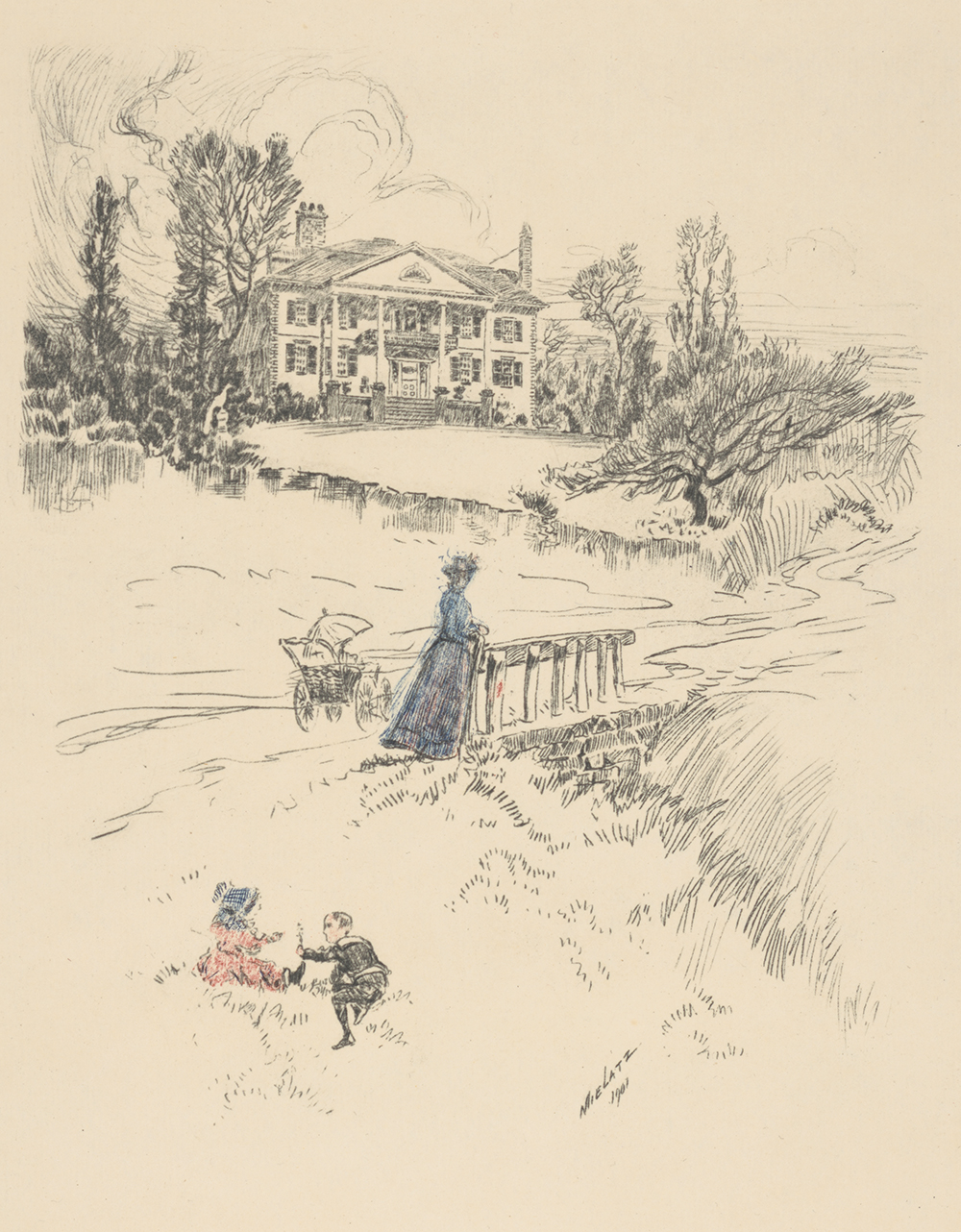
“I don’t have the sixth sense or anything like that,” Carbone says. “People expect me to scream at the spirits or try to do all the dramatic stuff you see on TV. I’ve never once had to raise my voice on a ghost hunt. We don’t do that.”
Led by Carbone and another staffer, the investigations are half historic tour, half intro to ghost hunting. The guests get much of the same information they would on a traditional tour, plus the added thrills of getting to walk into rooms normally roped off to the public and—maybe—of encountering a ghost.
The tours start downstairs, which is decorated to Eliza’s specifications. She wrote Stephen that she wanted the inside to look like she was moving from the Roman Colosseum toward the heavens. Carbone keeps a set of basic ghost-hunting equipment at the house: a light that senses movement; small balls covered with multicolored lights that go off if they’re touched; a laser pen that projects a grid of dots; a pod that measures static electricity; and a meter, more commonly used by electricians, that measures electromagnetic fields. The last is a black box about the size and shape of a remote control, with a bank of lights at the top to indicate the strength of nearby fields. Held up to a voice recorder, its meter rises from a single green light to hold steady in the middle orange zone.
“That shows me it’s doing its job,” Carbone says. He then places it on a gold settee along the wall. The light of the sensor starts fluctuating up and down, into the higher red zone. “Now, why would it be going off over here?”
Eliza commissioned this piece from Duncan Phyfe, one of the country’s most sought-after cabinetmakers in the nineteenth century. Carbone takes the meter off the furniture, and it quiets. “I’m not saying it’s definitely a ghost,” he says. “It’s just very interesting.”
In the parlor, he puts the meter on a small chair, upholstered in blue, set in the middle of the room; it also had belonged to Eliza. Again the device flickers red.
It’s enough to make the ghost-wary a little bit nervous. Eliza seemed tough enough to contend with in life; death can’t have made her temperament any sweeter. After she died, her disgruntled heirs worked to invalidate her will by proving that her mental capacities had failed her. It’s possible that many of the malicious rumors about her date to this period. It’s unlikely, for instance, that Eliza caused her husband’s death. (In another version of the story, he dies of pneumonia.) In the early nineteenth century, Carbone points out, women had few legal rights. Eliza stood to inherit a fortune. If she had been a suspect in her husband’s death, she almost certainly would have been investigated. There’s no evidence that happened.
“For some reason, when someone dies, they are automatically turned evil and vengeful,” says Carbone. “Eliza happened to be very smart and very successful. And we still see this today—a successful, smart woman equates to ‘Oh, she’s got to be evil.’ That’s where all that garbage comes from. Part of our job is to dispel those rumors. That’s a big reason as to why we do these ghost hunts, is to get rid of decades worth of rumors and gossip.”
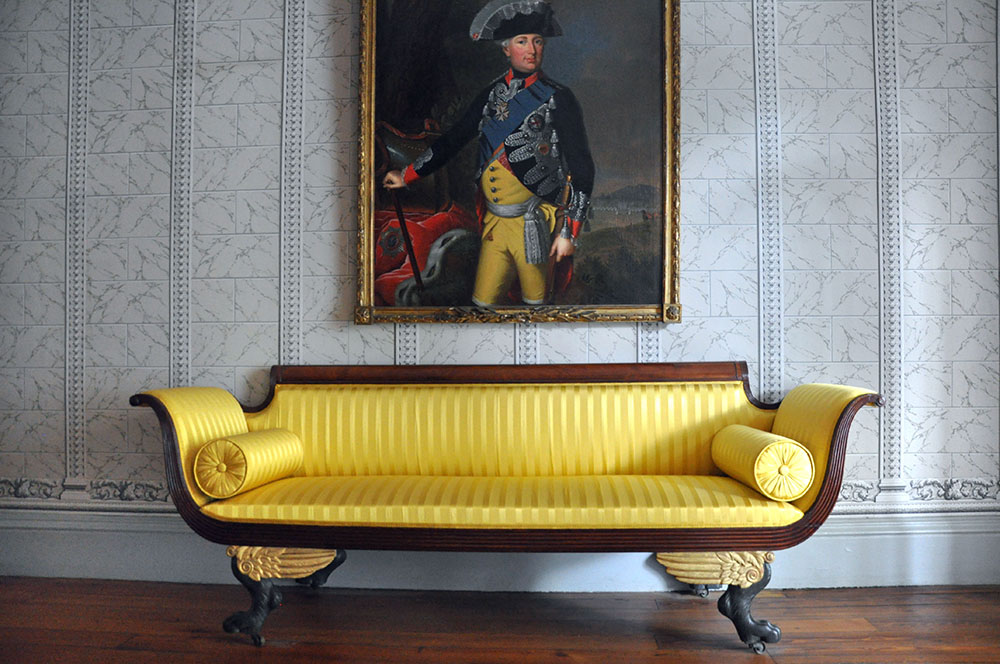
On their own, pieces of historic furniture don’t quite command the same attention as the suggestion that a ghost might be sitting in one. To Eliza’s credit, the settee and the chair are very tasteful, and if a person were to stick around after death, they’d probably still want to enjoy their best things. As a ghost, Eliza seems like a pleasant enough housemate. On the paranormal investigations, Carbone leads an exercise where he splits up men and women and has each group go into Eliza’s room. The paranormal activity when the women goes in seems to be higher, according to Carbone—Eliza may prefer female companionship. Over the years that he’s worked here, Carbone has measured the most paranormal activity at galas and performances. Actress Eliza loved to entertain; her relationship with Burr began after her nephew convinced her to invite him for dinner.
While we’re sitting downstairs in the kitchen, the ghost-hunting gear set up around us, Carbone shows me a video on his phone. He and his colleagues were trying to re-create the music of the nineteenth century, a soundscape they assumed would be familiar to at least some of the spectral guests, given their age, in the hope it might bring them out. On the recording, a group of very alive people are talking when a high-pitched sound, a mix of an unhappy cat and a record scratch, cuts in. None of them react.
“What’s it sound like to you?” Carbone asks me. “We all think it says, ‘They’re going to laugh at you.’ ”
At that moment, one of the motion-detecting balls, which he’d placed in a pot in the big fireplace across the room, lights up.
“That was pretty cool,” he says. “Can you do that again?” he asks, addressing the still and seemingly empty room. “Can you touch one of these?”
The balls stays dark, and the other equipment is quiet. The kitchen would have been occupied mostly by servants, including for a time Anne Northup, the wife of Solomon Northup, the kidnapped black man who wrote Twelve Years a Slave.
“People come here and say, ‘George, is that you? Eliza, is that you?’ ” says Carbone. “You don’t know what happened here. You could be saying ‘Eliza, is that you?’ and meanwhile you’ve got one hundred other ghosts in the room saying, ‘Hey, what about me?’ ”